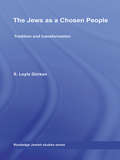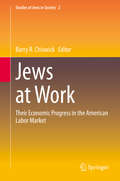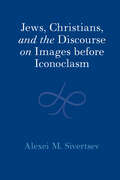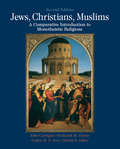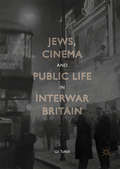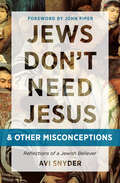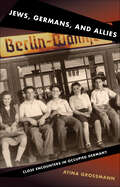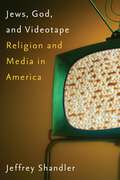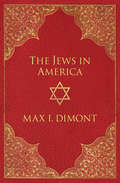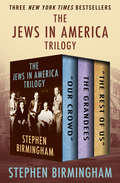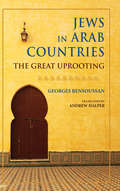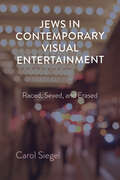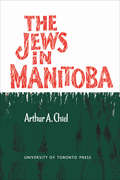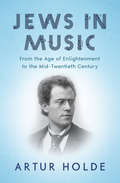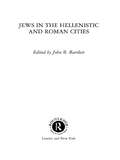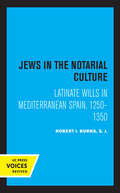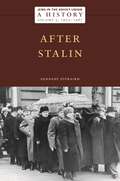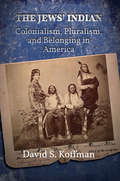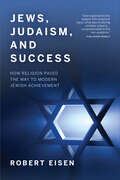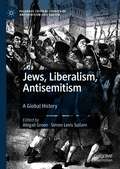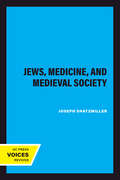- Table View
- List View
The Jews as a Chosen People: Tradition and transformation (Routledge Jewish Studies Series)
by S. Leyla GurkanThe concept of the Jews as a chosen people is a key element of the Jewish faith and identity. This book explores the idea of chosenness from the ancient world, through modernity and into the Post-Holocaust era. Analysing a vast corpus of biblical, ancient, rabbinic and modern Jewish literature, the author seeks to give a better understanding of this central doctrine of the Jewish religion. She shows that although the idea of chosenness has been central to Judaism and Jewish self-definition, it has not been carried to the present day in the same form. Instead it has gone through constant change, depending on who is employing it, against what sort of background, and for what purpose. Surveying the different and sometimes conflicting interpretations of the doctrine of chosenness that appear in Ancient, Modern, and Post-Holocaust periods, the dominant themes of ‘Holiness’, ‘Mission’, and ‘Survival’ are identified in each respective period. The theological, philosophical, and sociological dimensions of the question of Jewish chosenness are thus examined in their historical context, as responses to the challenges of Christianity, Modernity, and the Holocaust in particular. This book will be of interest to scholars and students of Jewish Studies, the Holocaust, religion and theology.
Jews at Work: Their Economic Progress in the American Labor Market (Studies of Jews in Society #2)
by Barry R. ChiswickThis book addresses the educational, occupational, and income progress of Jews in the American labor market. Using theoretical and statistical findings, it compares the experience of American Jews with that of other Americans, from the middle of the 19th century through the 20th and into the early 21st century.Jews in the United States have been remarkably successful; from peddlers and low-skilled factory workers, clearly near the bottom of the economic ladder, they have, as a community, risen to the top of the economic ladder. The papers included in this volume, all authored or co-authored by Barry Chiswick, address such issues as the English language proficiency, occupational attainment and earnings of Jews, educational and labor market discrimination against Jews, life cycle and labor force participation patterns of Jewish women, and historical and methodological issues, among many others. The final chapter analyzes alternative explanations for the consistently high level of educational and economic achievement of American Jewry over the past century and a half. The chapters in this book also develop and demonstrate the usefulness of alternative techniques for identifying Jews in US Census and survey data where neither religion nor Jewish ethnicity is explicitly identified. This methodology is also applicable to the study of other minority groups in the US and in other countries.
Jews, Christians, and the Discourse on Images before Iconoclasm
by Alexei M. SivertsevBetween the sixth and eighth centuries CE, the image emerged as a rhetorical category in religious literature produced in the Mediterranean basin. The development was not a uniquely Christian phenomenon. Rather, it emerged in the context of broader debates about symbolic forms that took place across a wide range of ethnic, linguistic, and religious groups who inhabited the late Roman and early Byzantine world. In this book, Alexei Sivertsev demonstrates how Jewish texts serve as an important, and until recently overlooked, witness to the formation of image discourse and associated practices of image veneration in late antiquity and the early Middle Ages. Addressing the role of the image as a rhetorical device in Jewish liturgical poetry, Sivertsev also considers the theme of the engraved image of Jacob in its early Byzantine context and the aesthetics of spaces that bridge the gap between the material and the immaterial in early Byzantine imagination.
Jews, Christians, Muslims: A Comparative Introduction to Monotheistic Religions
by Carlos Eire John Corrigan Frederick Denny Martin S JaffeeThematic examination of monotheistic religions The second edition of Jews, Christians, Muslims: A Comparative Introduction to Monotheistic Religions, compares Judaism, Christianity, and Islam using seven common themes which are equally relevant to each tradition. Provoking critical thinking, this text addresses the cultural framework of religious meanings and explores the similarities and differences among Judaism, Christianity, and Islam as it explains the ongoing process of interpretation in each religion. The book is designed for courses in Western and World Religions.
Jews, Cinema and Public Life in Interwar Britain
by Gil ToffellThis book investigates a Jewish orientation to film culture in interwar Britain. It explores how pleasure, politics and communal solidarity intermingled in the cinemas of Jewish neighbourhoods, and how film was seen as a vessel through which Jewish communal concerns might be carried to a wider public. Addressing an array of related topics, this volume examines the lived expressive cultures of cinemas in Jewish areas and the ethnically specific films consumed within these sites; the reception of film stars as representations of a Jewish social body; and how an antisemitic canard that understood the cinema as a Jewish monopoly complicated its use as a base for anti-fascist activity. In shedding light on an unexplored aspect of British film reception and exhibition, Toffell provides a unique insight into the making of the modern city by migrant communities. The title will be of use to anyone interested in Britain’s interwar leisure landscape, the Jewish presence in modernity, and a cinema studies sensitised to the everyday experience of audiences.
Jews Don't Need Jesus. . .and other Misconceptions: Reflections of a Jewish Believer
by Avi SnyderA debate that's 2,000 years old, and running… Do Jews need Jesus? It&’s an age-old debate with eternal ramifications. If Jesus is not the Jewish Messiah, if He is not the savior of the world, if He is not the promised redeemer God sent to restore Israel and redeem the nations (Isaiah 49:6), then bringing His message to the Jewish people is a grave threat to their security. But if He is the prophet God promised to raise up, if God did indeed command Israel to follow Him, and if the Jews will be held accountable by God if they don&’t accept Jesus, then sharing His message is beyond imperative. Jesus is either &“Lord of all or not Lord at all.&” The stakes couldn&’t be higher. Jews Don&’t Need Jesus… and Other Misconceptions settles this dispute with biblical evidence. It argues that believing in Jesus isn&’t apostasy; it&’s obedience, and it leads to eternal blessing. That&’s what makes this book critical for Jewish people or anyone in gospel ministry to the Jews.
Jews Don't Need Jesus. . .and other Misconceptions: Reflections of a Jewish Believer
by Avi SnyderA debate that's 2,000 years old, and running… Do Jews need Jesus? It&’s an age-old debate with eternal ramifications. If Jesus is not the Jewish Messiah, if He is not the savior of the world, if He is not the promised redeemer God sent to restore Israel and redeem the nations (Isaiah 49:6), then bringing His message to the Jewish people is a grave threat to their security. But if He is the prophet God promised to raise up, if God did indeed command Israel to follow Him, and if the Jews will be held accountable by God if they don&’t accept Jesus, then sharing His message is beyond imperative. Jesus is either &“Lord of all or not Lord at all.&” The stakes couldn&’t be higher. Jews Don&’t Need Jesus… and Other Misconceptions settles this dispute with biblical evidence. It argues that believing in Jesus isn&’t apostasy; it&’s obedience, and it leads to eternal blessing. That&’s what makes this book critical for Jewish people or anyone in gospel ministry to the Jews.
Jews, Gentiles, and Other Animals: The Talmud After the Humanities (Divinations: Rereading Late Ancient Religion)
by Mira Beth WassermanIn Jews, Gentiles, and Other Animals, Mira Beth Wasserman undertakes a close reading of Avoda Zara, arguably the Talmud's most scandalous tractate, to uncover the hidden architecture of this classic work of Jewish religious thought. She proposes a new way of reading the Talmud that brings it into conversation with the humanities, including animal studies, the new materialisms, and other areas of critical theory that have been reshaping the understanding of what it is to be a human being.Even as it comments on the the rabbinic laws that govern relations between Jews and non-Jews, Avoda Zara is also an attempt to reflect on what all people share in common, and on how humans fit into a larger universe of animals and things. As is typical of the Talmud in general, it proceeds by incorporating a vast and confusing array of apparently digressive materials, but Wasserman demonstrates that there is a whole greater than the sum of the parts, a sustained effort to explore human identity and difference.In centuries past, Avoda Zara has been a flashpoint in Jewish-Christian relations. It was partly due to its content that the Talmud was subject to burning and censorship by Christian authorities. Wasserman develops a twenty-first-century reading of the tractate that aims to reposition it as part of a broader quest to understand what connects human beings to each other and to the world around them.
Jews, Germans, and Allies: Close Encounters in Occupied Germany
by Atina GrossmannIn the immediate aftermath of World War II, more than a quarter million Jewish survivors of the Holocaust lived among their defeated persecutors in the chaotic society of Allied-occupied Germany. Jews, Germans, and Allies draws upon the wealth of diary and memoir literature by the people who lived through postwar reconstruction to trace the conflicting ways Jews and Germans defined their own victimization and survival, comprehended the trauma of war and genocide, and struggled to rebuild their lives. In gripping and unforgettable detail, Atina Grossmann describes Berlin in the days following Germany's surrender--the mass rape of German women by the Red Army, the liberated slave laborers and homecoming soldiers, returning political exiles, Jews emerging from hiding, and ethnic German refugees fleeing the East. She chronicles the hunger, disease, and homelessness, the fraternization with Allied occupiers, and the complexities of navigating a world where the commonplace mingled with the horrific. Grossmann untangles the stories of Jewish survivors inside and outside the displaced-persons camps of the American zone as they built families and reconstructed identities while awaiting emigration to Palestine or the United States. She examines how Germans and Jews interacted and competed for Allied favor, benefits, and victim status, and how they sought to restore normality--in work, in their relationships, and in their everyday encounters.Jews, Germans, and Allies shows how Jews were integral participants in postwar Germany and bridges the divide that still exists today between German history and Jewish studies.
Jews, God, and Videotape: Religion and Media in America
by Jeffrey ShandlerA pioneering examination of the impact of new communications technologies and media practices on the religious life of American JewryEngaging media has been an ongoing issue for American Jews, as it has been for other religious communities in the United States, for several generations. Shandler’s examples range from early recordings of cantorial music to Hasidic outreach on the Internet. In between he explores mid-twentieth-century ecumenical radio and television broadcasting, video documentation of life cycle rituals, museum displays and tourist practices as means for engaging the Holocaust as a moral touchstone, and the role of mass-produced material culture in Jews’ responses to the American celebration of Christmas.Shandler argues that the impact of these and other media on American Judaism is varied and extensive: they have challenged the role of clergy and transformed the nature of ritual; facilitated innovations in religious practice and scholarship, as well as efforts to maintain traditional observance and teachings; created venues for outreach, both to enhance relationships with non-Jewish neighbors and to promote greater religiosity among Jews; even redefined the notion of what might constitute a Jewish religious community or spiritual experience. As Jews, God, and Videotape demonstrates, American Jews’ experiences are emblematic of how religious communities’ engagements with new media have become central to defining religiosity in the modern age.
The Jews in America: The Roots, History And Destiny Of American Jews
by Max I. Dimont"The Jews in the United States are the inheritors of a four-thousand-year-old culture. Into their willing--or unwilling--hands, history has placed the symbolic scepter of this heritage. Will this Jewish culture--entrusted to the American Jews either by blind permutations of events or by a manifest destiny--wither in a wasteland of indifference? Or will there be a renaissance--a humanistic rebirth--to ensure this culture continued growth?
The Jews in America Trilogy: "Our Crowd," The Grandees, and "The Rest of Us"
by Stephen BirminghamThree New York Times bestsellers chronicle the rise of America&’s most influential Jewish families as they transition from poor immigrants to household names. In his acclaimed trilogy, author Stephen Birmingham paints an engrossing portrait of Jewish American life from the colonial era through the twentieth century with fascinating narrative and meticulous research. The collection&’s best-known book, &“Our Crowd&” follows nineteenth-century German immigrants with recognizable names like Loeb, Sachs, Lehman, Guggenheim, and Goldman. Turning small family businesses into institutions of finance, banking, and philanthropy, they elevated themselves from Lower East Side tenements to Park Avenue mansions. Barred from New York&’s gentile elite because of their religion and humble backgrounds, they created their own exclusive group, as affluent and selective as the one that had refused them entry. The Grandees travels farther back in history to 1654, when twenty-three Sephardic Jews arrived in New York. Members of this small and insulated group—considered the first Jewish community in America—soon established themselves as wealthy businessmen and financiers. With descendants including poet Emma Lazarus, Barnard College founder Annie Nathan Meyer, and Supreme Court Justice Benjamin N. Cardozo, these families were—and still are—hugely influential in the nation&’s culture, politics, and economics. In &“The Rest of Us,&” Birmingham documents the third major wave of Jewish immigration: Eastern Europeans who swept through Ellis Island between 1880 and 1924. These refugees from czarist Russia and Polish shtetls were considered barbaric, uneducated, and too steeped in the traditions of the &“old country&” to be accepted by the well-established German American Jews. But the new arrivals were tough, passionate, and determined. Their incredible rags to riches stories include those of the lives of Hollywood tycoon Samuel Goldwyn, Broadway composer Irving Berlin, makeup mogul Helena Rubenstein, and mobster Meyer Lansky. This unforgettable collection comprises a comprehensive account of the Jewish American upper class, their opulent world, and their lasting mark on American society.
Jews in Arab Countries: The Great Uprooting (Studies in Antisemitism)
by Georges BensoussanIn this new history, French author Georges Bensoussan retells the story of what life was like for Jews in the Arab world since 1850. During the early years of this time, it was widely believed that Jewish life in Arab lands was peaceful. Jews were protected by law and suffered much less violence, persecution, and inequality. Bensoussan takes on this myth and looks back over the history of Jewish-Arab relations in Arab countries. He finds that there is little truth to the myth and forwards a nuanced history of interrelationship that is not only diverse, but deals with local differences in cultural, religious, and political practice. Bensoussan divides the work into sections that cover 1850 to the end of WWI, from 1919 to the eve of WWII and then from WWII to the establishment of Israel and the Arab Wars. A new afterword brings the history of Jewish and Arab relations into the present day. Bensoussan has determined that the history of Jews in Arab countries is a history of slowly disintegrating relationships, increasing tension, violence, and persecution.
Jews in China: Cultural Conversations, Changing Perceptions (Dimyonot: Jews and the Cultural Imagination #7)
by Irene EberIrene Eber was one of the foremost authorities on Jews in China during the twentieth and twenty-first centuries—a field that, in contrast to the study of the Jewish diaspora in Europe and the Americas, has been critically neglected. This volume gathers fourteen of Eber’s most salient articles and essays on the exchanges between Jewish and Chinese cultures, making available to students, scholars, and general readers a representative sample of the range and depth of her important work in the field of Jews in China.Jews in China delineates the centuries-long, reciprocal dialogue between Jews, Jewish culture, and China, all under the overarching theme of cultural translation. The first section of the book sets forth a sweeping overview of the history of Jews in China, beginning in the twelfth century and concluding with a detailed assessment of the two crucial years leading up to the Second World War. The second section examines the translation of Chinese classics into Hebrew and the translation of the Hebrew Bible into Chinese. The third and final section turns to modern literature, bringing together eight essays that underscore the cultural reciprocity that takes place through acts of translation.The centuries-long relationship between Judaism and China is often overlooked in the light of the extensive discourse surrounding European and American Judaism. With this volume, Eber reminds us that we have much to learn from the intersections between Jewish identity and Chinese culture.
Jews in China: Cultural Conversations, Changing Perceptions (Dimyonot)
by Irene EberIrene Eber was one of the foremost authorities on Jews in China during the twentieth and twenty-first centuries—a field that, in contrast to the study of the Jewish diaspora in Europe and the Americas, has been critically neglected. This volume gathers fourteen of Eber’s most salient articles and essays on the exchanges between Jewish and Chinese cultures, making available to students, scholars, and general readers a representative sample of the range and depth of her important work in the field of Jews in China.Jews in China delineates the centuries-long, reciprocal dialogue between Jews, Jewish culture, and China, all under the overarching theme of cultural translation. The first section of the book sets forth a sweeping overview of the history of Jews in China, beginning in the twelfth century and concluding with a detailed assessment of the two crucial years leading up to the Second World War. The second section examines the translation of Chinese classics into Hebrew and the translation of the Hebrew Bible into Chinese. The third and final section turns to modern literature, bringing together eight essays that underscore the cultural reciprocity that takes place through acts of translation.The centuries-long relationship between Judaism and China is often overlooked in the light of the extensive discourse surrounding European and American Judaism. With this volume, Eber reminds us that we have much to learn from the intersections between Jewish identity and Chinese culture.
Jews in Contemporary Visual Entertainment: Raced, Sexed, and Erased
by Carol SiegelWhat are the consequences of how Jews are depicted in movies and television series? Drawing on a host of movies and television series from the 1970s to present day, Jews in Contemporary Visual Entertainment explores how the media sexualize and racialize American Jews. Race and sexuality frequently intersect in the depiction of Jewish characters in such shows as The Marvelous Mrs. Maisel, UnREAL, The Expanse, and Breaking Bad, and in films such as Hester Street, Once Upon a Time in America, Casino, Radio Days, Inglourious Basterds, and Barton Fink. When they do, American sexual norms are invariably challenged or outright broken by these anti-Semitic representations of Jewishness.Insightful and provocative, Jews in Contemporary Visual Entertainment disturbingly reveals the far-reaching influence of popular visual media in shaping how American Jews are perceived today.
The Jews in Manitoba
by Arthur A. ChielRabbi Chiel's history of the Jewish community in Manitoba grew out of a curiosity about the colour and vitality of Jewish life in this Canadian prairie province which was impressed upon him during a ten-year residence in Winnipeg. He was impelled as a result to record the events of that history and to try and fit the local Jewish experience into a larger historical panorama. His story has been built up by careful examination of Manitoba newspapers and early histories, by research in the archives of the province, and by interviews with surviving Jewish pioneers. It reveals with insight and skill how the Jewish community has, because of its distinctive character as an ethnic group and its participation with other groups in the development of the Prairies as a whole, made an outstanding contribution to provincial and national life in business, the professions, and the arts.His study is presented under the sponsorship of the Manitoba Historical Society which has encouraged a number of studies of the various ethnic groups in Manitoba. It has received the H.M. Caiserman Award of the Canadian Jewish Congress.
Jews in Music: From the Age of Enlightenment to the Mid-Twentieth Century
by Artur HoldeThis authoritative history chronicles the work and lives of great Jewish musicians around the world from the early nineteenth century to the mid-twentieth. Since the Age of Enlightenment, Jewish musicians, composers, and musicologists have greatly enriched the artistic legacies of cultures and countries on a global scale. Their contributions have been a major influence on numerous musical forms, both secular and sacred. Jews in Music presents a survey of these accomplishments through the rise of Zionism, the settlement of the Jewish Homeland, and the burgeoning Jewish music developments in America.Jews in Music presents a detailed history ranging from the symphonies of Felix Mendelssohn to the Broadway musicals of Leonard Bernstein, from the great touring violinists of Western Europe to the pioneers of commercial music recording. Plus, a section on sacred music explores in depth the evolution of the musical components of the synagogue, including the chants, compositions, and traditional songs of the chazzanim.
Jews in the Hellenistic and Roman Cities
by John R. BartlettArticles examine the city of Jerusalem and other Jewish communities of the Mediterranean diaspora, as reflected in the writings of Luke, Josephus and Philo. Topics covered include social identity, everyday life and religious practice.This will be of interest to students of Roman history, biblical studies, ancient Judaism and Hellenistic history.
Jews in the Notarial Culture: Latinate Wills in Mediterranean Spain, 1250–1350
by Robert I. Burns S. J.This title is part of UC Press's Voices Revived program, which commemorates University of California Press’s mission to seek out and cultivate the brightest minds and give them voice, reach, and impact. Drawing on a backlist dating to 1893, Voices Revived makes high-quality, peer-reviewed scholarship accessible once again using print-on-demand technology. This title was originally published in 1996.
Jews in the Soviet Union: After Stalin, 1953–1967, Volume 5
by Gennady EstraikhOffers an analysis of Soviet Jewish society after the death of Joseph StalinAt the beginning of the twentieth century, more Jews lived in the Russian Empire than anywhere else in the world. After the Holocaust, the USSR remained one of the world’s three key centers of Jewish population, along with the United States and Israel. While a great deal is known about the history and experiences of the Jewish people in the US and in Israel in the twentieth century, much less is known about the experiences of Soviet Jews. Understanding the history of Jewish communities under Soviet rule is essential to comprehending the dynamics of Jewish history in the modern world. Only a small number of scholars and the last generation of Soviet Jews who lived during this period hold a deep knowledge of this history. Jews in the Soviet Union, a new multi-volume history, is an unprecedented undertaking. Publishing over the next few years, this groundbreaking work draws on rare access to documents from the Soviet archives, allowing for the presentation of a sweeping history of Jewish life in the Soviet Union from 1917 through the early 1990s.Volume 5 offers a history of Soviet Jewry from the demise of the brutal dictator Joseph Stalin to the military confrontation between Israel and Arab states in 1967 known as the Six-Day War. Both historic events deeply affected Soviet Jews, who numbered over two million in the wake of the Holocaust and still formed at that point the second-largest Jewish population in the world. Stalin’s death led to the release of political prisoners and the reduction of the level of fear in society. The economy was growing and conditions of life were improving. At the same time, the state had doubts about the loyalty of the Jewish population and imposed limitations on their educational and career prospects. The relatively liberal period associated with Nikita Khrushchev’s “thaw” after the Stalinist bitter frost became a prelude to the years when contemplation about, or practical steps toward, emigration to Israel or elsewhere began to play an increasing role in the lives of Soviet Jews. In this pioneering analysis of the “thaw” years in Soviet Jewish history, Gennady Estraikh focuses both on the factors driving emigration and dissent, and on those Jews who were able to attain a high standard of living, and to rise to esteemed positions in managerial, academic, bohemian, and other segments of the Soviet elite.
The Jews’ Indian: Colonialism, Pluralism, and Belonging in America
by David S. KoffmanThe Jews’ Indian investigates the history of American Jewish relationships with Native Americans, both in the realm of cultural imagination and in face-to-face encounters. These two groups’ exchanges were numerous and diverse, proving at times harmonious when Jews’ and Natives people’s economic and social interests aligned, but discordant and fraught at other times. American Jews could be as exploitative of Native cultural, social, and political issues as other American settlers, and historian David Koffman argues that these interactions both unsettle and historicize the often triumphant consensus history of American Jewish life. Focusing on the ways Jewish class mobility and civic belonging were wrapped up in the dynamics of power and myth making that so severely impacted Native Americans, this books is provocative and timely, the first history to critically analyze Jewish participation in, and Jews’ grappling with the legacies of Native American history and the colonial project upon which America rests
Jews, Judaism, and Success: How Religion Paved the Way to Modern Jewish Achievement
by Robert EisenIn Jews, Judaism, and Success, Robert Eisen attempts to solve a long-standing mystery that has fascinated many: How did Jews become such a remarkably successful minority in the modern Western world? Eisen argues that Jews achieved such success because they were unusually well-prepared for it by their religion – in particular, Rabbinic Judaism, or the Judaism of the rabbis. Rooted in the Talmud, this form of Judaism instilled in Jews key values that paved the way for success in modern Western society: autonomy, freedom of thought, worldliness, and education. The book carefully analyses the evolution of these four values over the past two thousand years in order to demonstrate that they had a longer and richer history in Jewish culture than in Western culture. The book thus disputes the common assumption that Rabbinic Judaism was always an obstacle to Jews becoming modernized. It demonstrates that while modern Jews rejected aspects of Rabbinic Judaism, they also retained some of its values, and these values in particular led to Jewish success. Written for a broad range of readers, Jews, Judaism, and Success provides unique insights on the meaning of success and how it is achieved in the modern world.
Jews, Liberalism, Antisemitism: A Global History (Palgrave Critical Studies of Antisemitism and Racism)
by Abigail Green Simon Levis Sullam“This is a timely contribution to some of the most pressing debates facing scholars of Jewish Studies today. It forces us to re-think standard approaches to both antisemitism and liberalism. Its geographic scope offers a model for how scholars can “provincialize” Europe and engage in a transnational approach to Jewish history. The book crackles with intellectual energy; it is truly a pleasure to read.”- Jessica M. Marglin, University of Southern California, USAGreen and Levis Sullam have assembled a collection of original, and provocative essays that, in illuminating the historic relationship between Jews and liberalism, transform our understanding of liberalism itself. - Derek Penslar, Harvard University, USA“This book offers a strikingly new account of Liberalism’s relationship to Jews. Previous scholarship stressed that Liberalism had to overcome its abivalence in order to achieve a principled stand on granting Jews rights and equality. This volume asserts, through multiple examples, that Liberalism excluded many groups, including Jews, so that the exclusion of Jews was indeed integral to Liberalism and constitutive for it. This is an important volume, with a challenging argument for the present moment.”- David Sorkin, Yale University, USAThe emancipatory promise of liberalism – and its exclusionary qualities – shaped the fate of Jews in many parts of the world during the age of empire. Yet historians have mostly understood the relationship between Jews, liberalism and antisemitism as a European story, defined by the collapse of liberalism and the Holocaust. This volume challenges that perspective by taking a global approach. It takes account of recent historical work that explores issues of race, discrimination and hybrid identities in colonial and postcolonial settings, but which has done so without taking much account of Jews. Individual essays explore how liberalism, citizenship, nationality, gender, religion, race functioned differently in European Jewish heartlands, in the Mediterranean peripheries of Spain and the Ottoman empire, and in the North American Atlantic world.
Jews, Medicine, and Medieval Society: A Phenomenology Of Miscarriage
by Joseph ShatzmillerJews were excluded from most professions in medieval, predominantly Christian Europe. Bigotry was widespread, yet Jews were accepted as doctors and surgeons, administering not only to other Jews but to Christians as well. Why did medieval Christians suspend their fear and suspicion of the Jews, allowing them to inspect their bodies, and even, at times, to determine their survival? What was the nature of the doctor-patient relationship? Did the law protect Jewish doctors in disputes over care and treatment?Joseph Shatzmiller explores these and other intriguing questions in the first full social history of the medieval Jewish doctor. Based on extensive archival research in Provence, Spain, and Italy, and a deep reading of the widely scattered literature, Shatzmiller examines the social and economic forces that allowed Jewish medical professionals to survive and thrive in thirteenth- and fourteenth-century Europe. His insights will prove fascinating to scholars and students of Judaica, medieval history, and the history of medicine.
